James Golden’s Federal Twist garden is like Fight Club, except we do talk about it
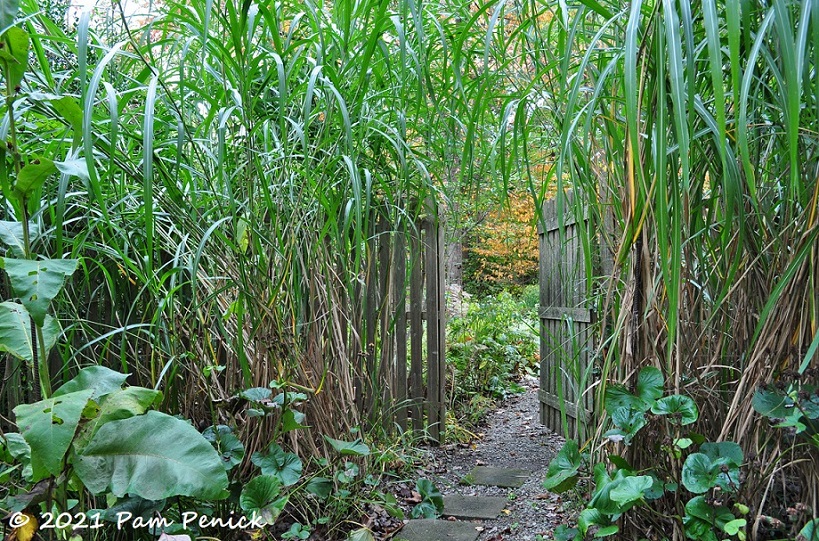
Plants duke it out for space and sunlight in every garden. But at Federal Twist, a wet-meadow garden in a clearing in the woods near Stockton, New Jersey, you witness the brawling fistfight from inside the ring. Grasses towering way over head-high spar with masses of coarse-leaved perennials. Ranks of 8-foot stalks push against path edges, and foliage bear-hugs chairs placed deep within the garden. Keep moving, the plants seem to say, or you’re next.
The ringmaster of this thoughtfully controlled chaos is James Golden, a deep-voiced, slow-spoken gardening philosopher brought up in Mississippi but transplanted long ago to his true home in New York City. After puttering in a tiny Brooklyn backyard for years, he and husband Phillip acquired a modest second home on 1-1/2 acres in the Garden State, perched on a slope of damp clay and eastern red cedar. James chopped down 70 or 80 trees to bring sunlight into the wooded lot and fenced out the deer. And then he planted masses of all the big, vigorous, muck-loving plants he could find.
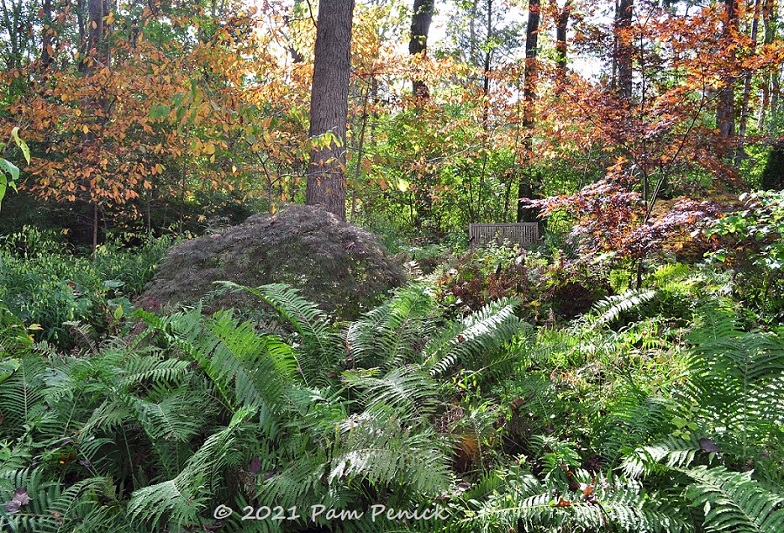
Today Federal Twist — named after a local road — is celebrated as a new kind of garden, one in harmony with its place and one that lets nature take the reins. It’s been featured by Monty Don on his BBC television show, written about in the New York Times and Gardens Illustrated, and discussed by leading garden thinkers like Thomas Rainer.
James is modestly gracious about all the attention and shares his ideas about his garden — as well as his firm likes and dislikes (including the actual labor of gardening) — through public talks, podcast interviews, and online lectures. In fact he’ll be giving an online talk via Wave Hill on February 16, which I’ve already signed up for.
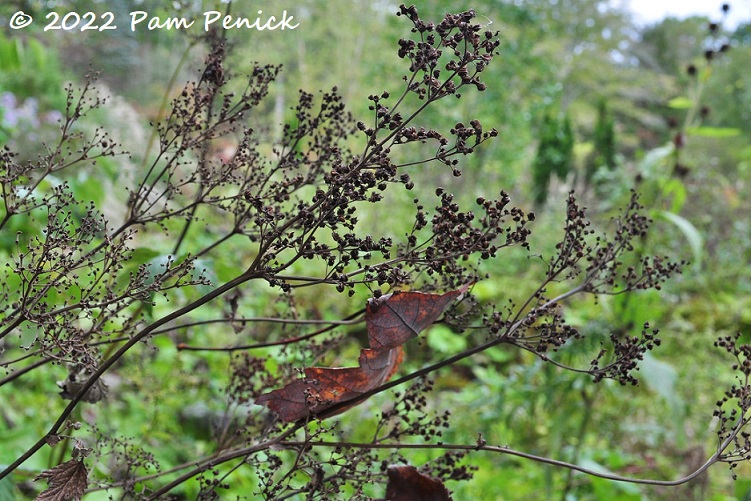
And although his wonderful blog, View from Federal Twist, isn’t active right now, it’s where he’s been sharing deeply philosophical musings about his own garden and gardens in general for the past 15 years or so. Be sure to check out an October 2020 post with drone shots of his garden to get a helpfully orienting bird’s-eye view, and to admire the mesmerizing foliage textures and colors visible from above. You can also find James on Instagram.
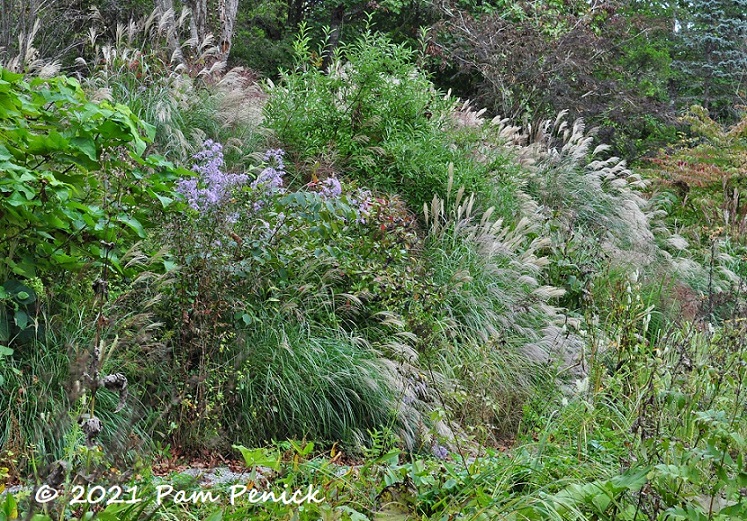
In March, James has a widely anticipated book coming out, The View from Federal Twist: A New Way of Thinking About Gardens, Nature and Ourselves. As soon as I get my hands on a copy I plan to share a review with you.
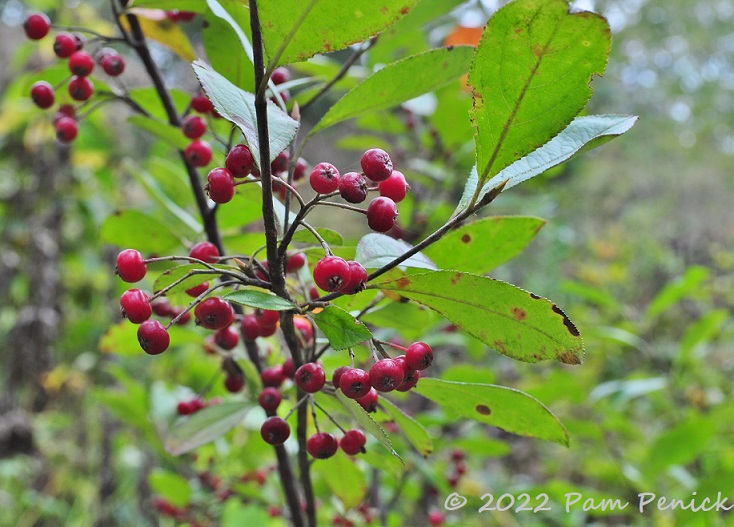
But now, come along with me on a mid-October stroll through James’s garden. During my big road trip through New England and down to Virginia last fall, I’d arranged to meet up with James for lunch and a garden visit. As I left Long Island, trying to circumvent New York City, I missed an exit and ended up driving through Manhattan, astonished to find myself cruising past a line of tourists outside the Empire State Building.
Exploring Federal Twist
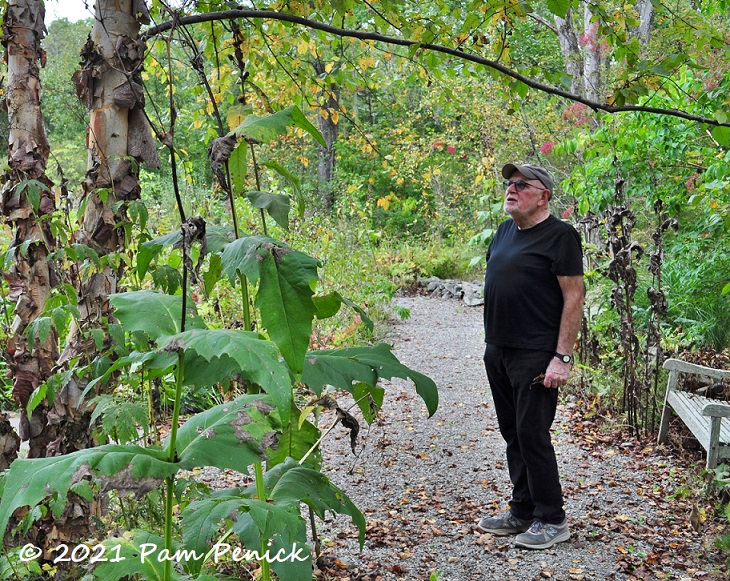
Despite the midtown detour, I arrived on time and met James for a patio lunch in charming Frenchtown, and then I followed him in my rental along tree-lined country lanes to his home. For the next hour or two I wandered the garden with him and his little dog Joey, bathed in a flow of botanical names of plants largely unfamiliar to this Texas gardener. I won’t try to identify them for you. Just immerse yourself in the scenery and enjoy the twists and turns of Federal Twist, as I did.

Joey, an adorable garden companion
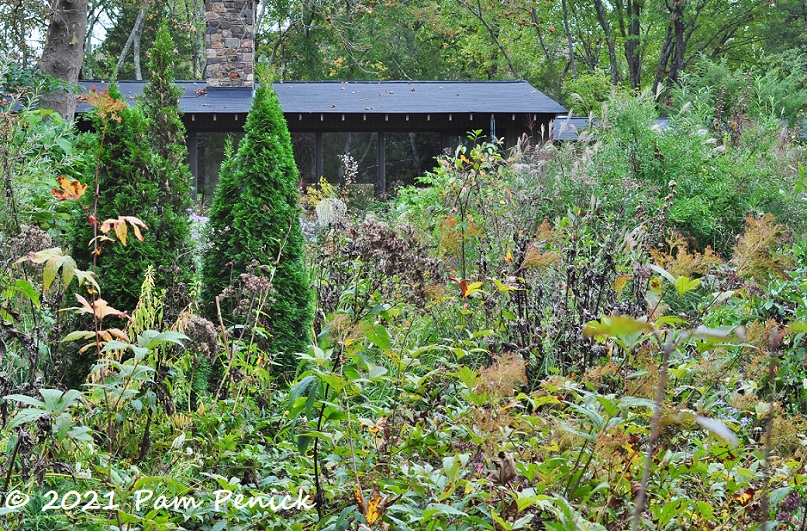
James first led me along the lower paths of his garden. Here and there above the semi-wild exuberance of his plants, I’d catch a glimpse of his 1965 ranch home, with floor-to-ceiling windows overlooking the garden.
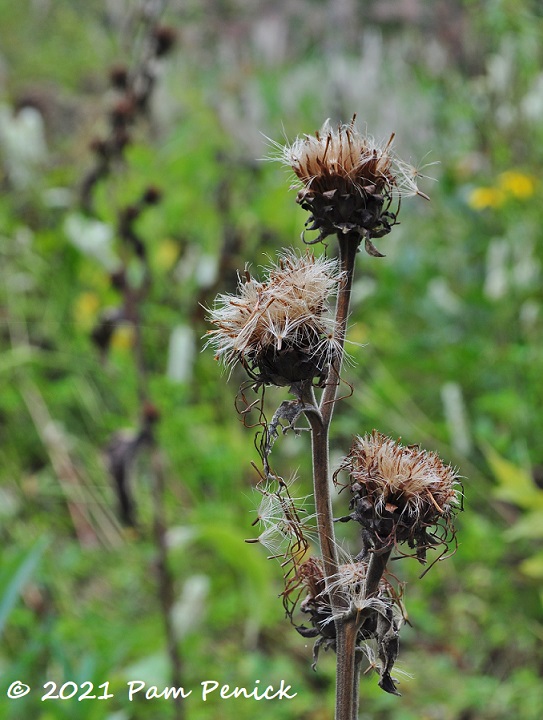
Mid-October is an in-between time to visit, he told me — after summer’s flowering but before the grasses and other plants turn orange, yellow, and red. Still, I found seasonal interest in black-stemmed seedheads, reddening berries, and towering, waving inflorescences of miscanthus and other grasses.
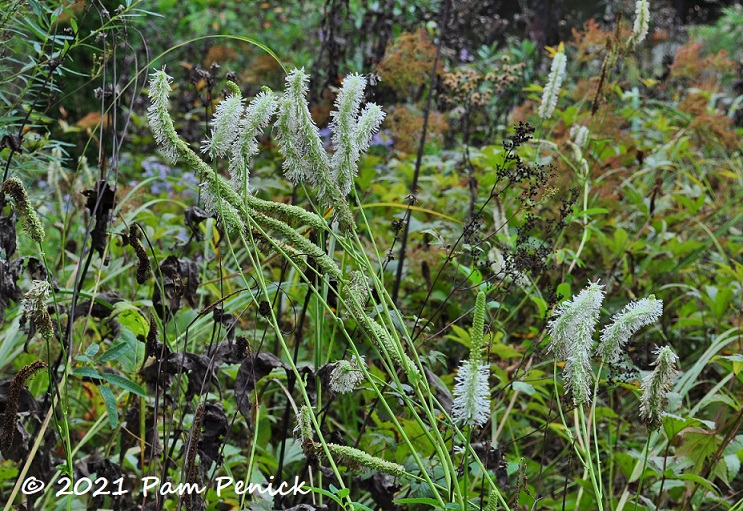
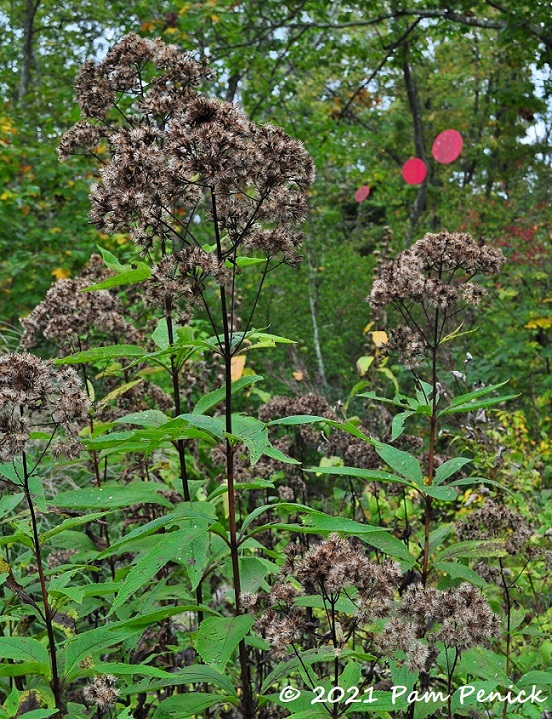
Plants are the stars in James’s garden, but he does have a few pieces of garden art, including a red-disc mobile high in a tree.
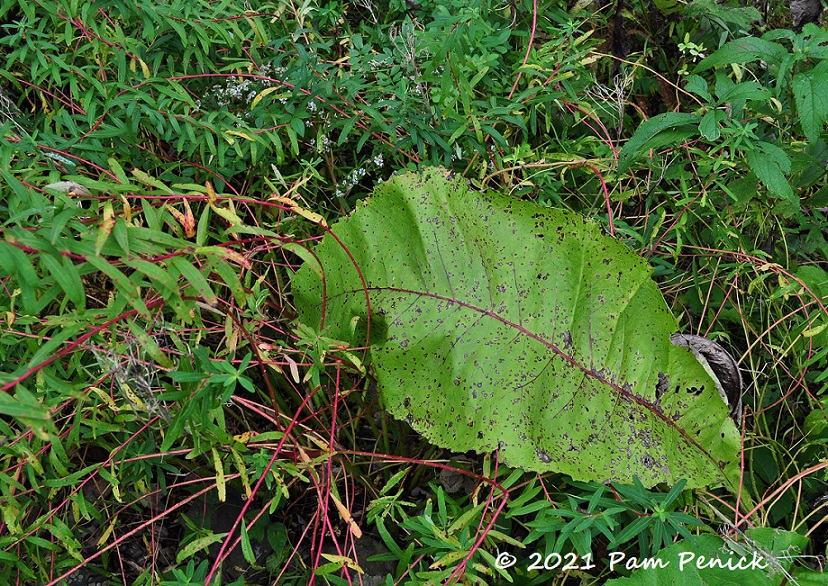
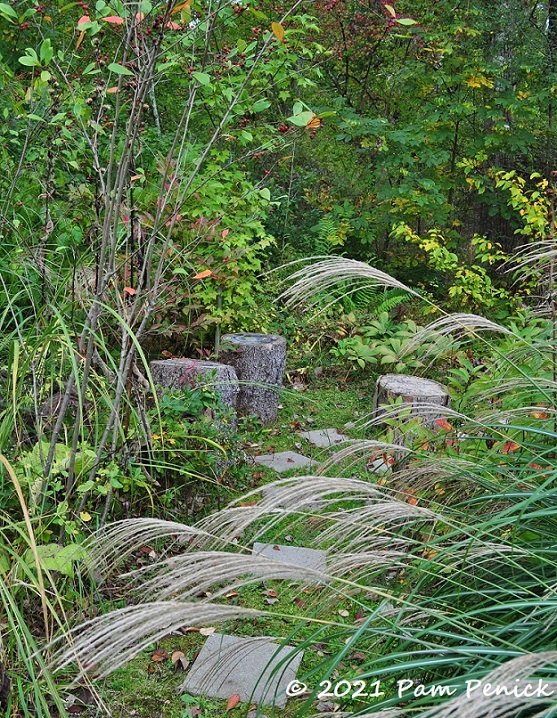
A side path with concrete pavers to keep your feet dry leads through a veil of grasses to tree-stump stools. A secret meeting place.
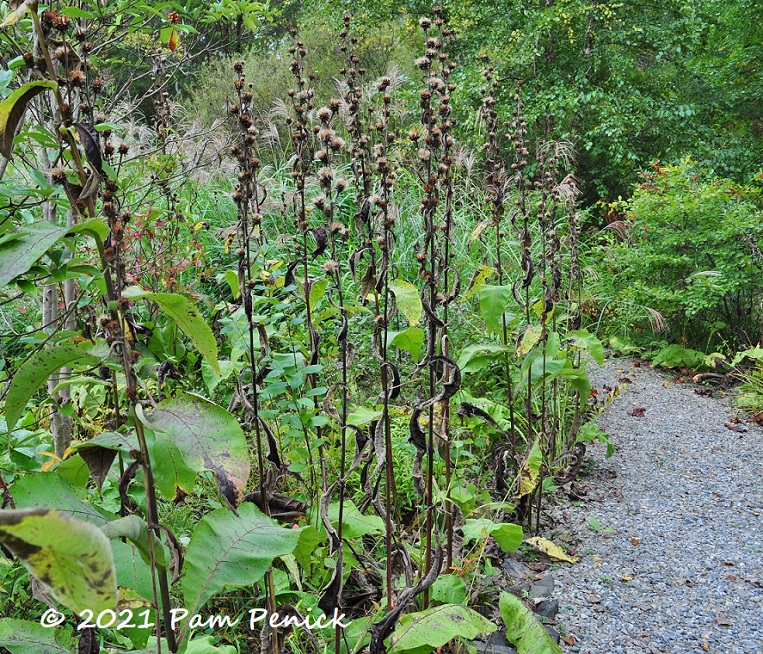
Inula racemosa ‘Sonnenspeer’
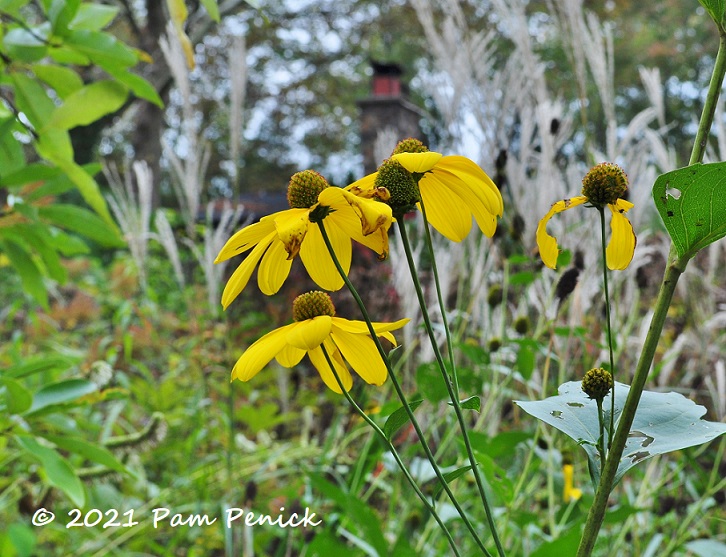
Stone circle
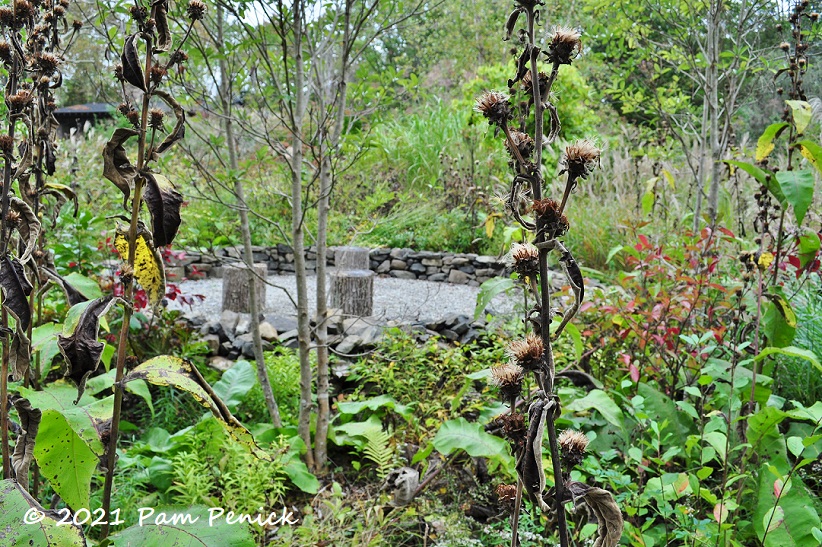
The lush, pressing foliage is relieved by open spaces like this wide stone circle — a council ring, to my mind, although James doesn’t like calling it that.
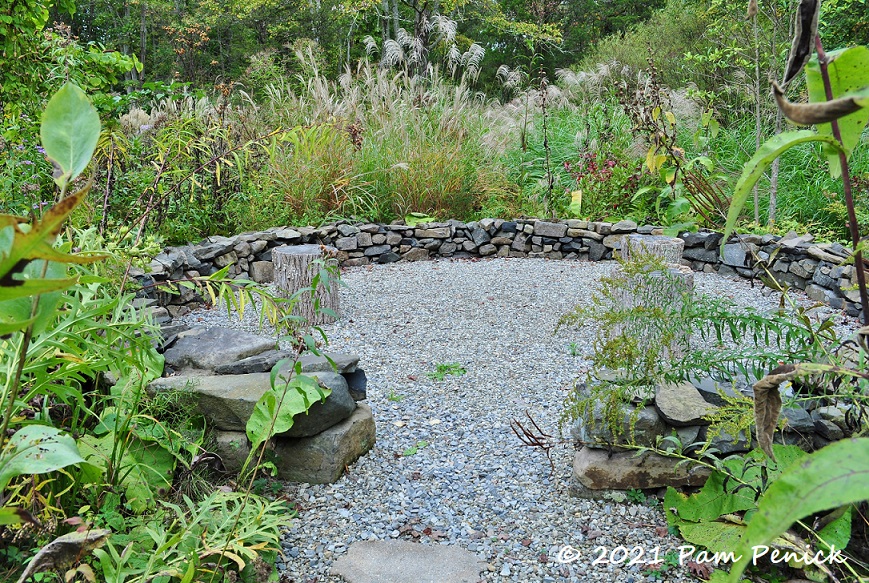
A low band of dark rock encircles three stump stools — a wonderfully effective use of negative space amid all the tall grasses.
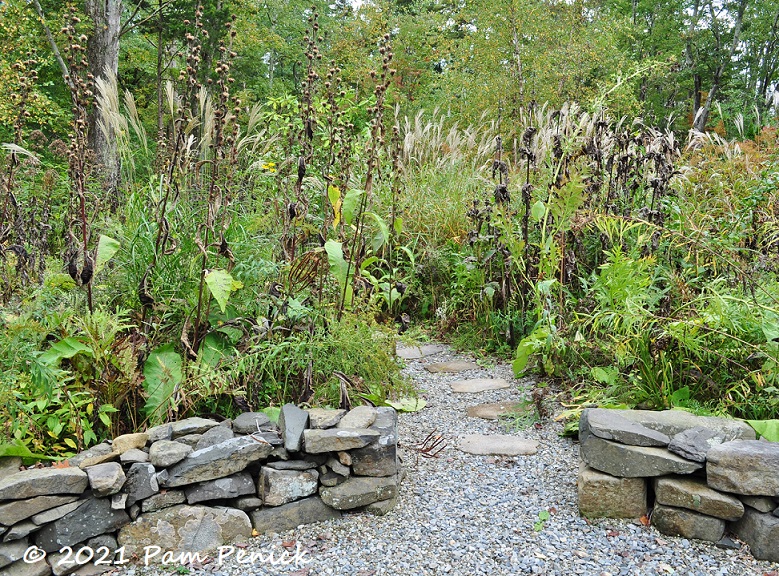
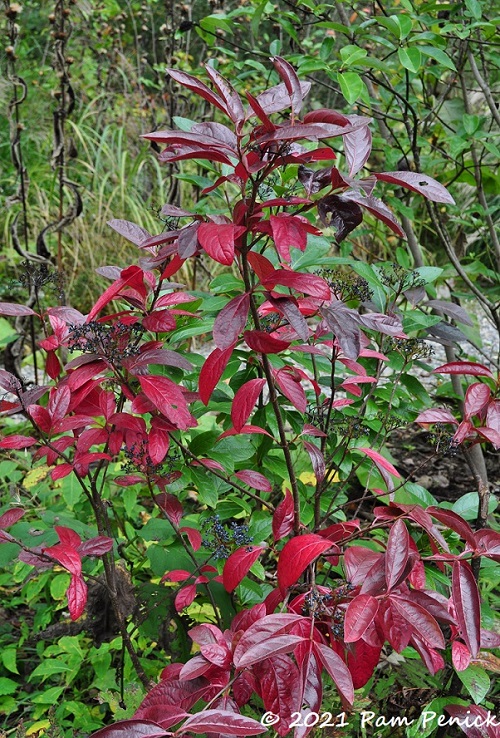
A bit of fall color
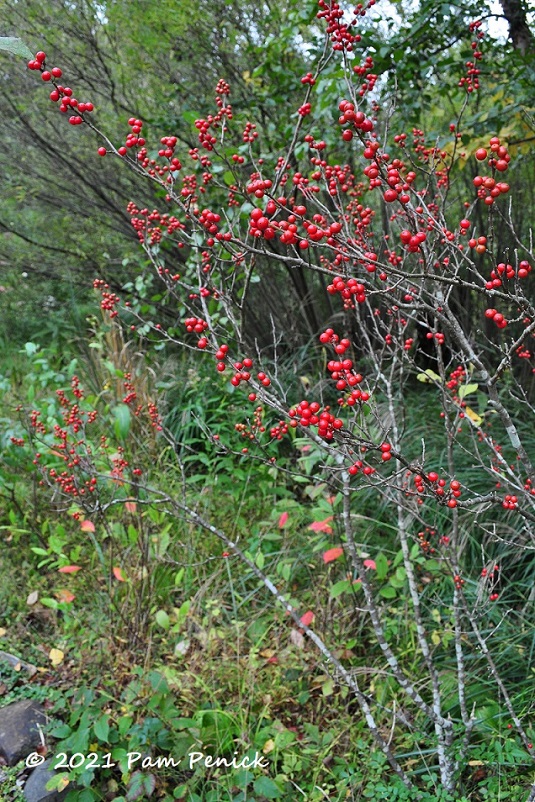
And more
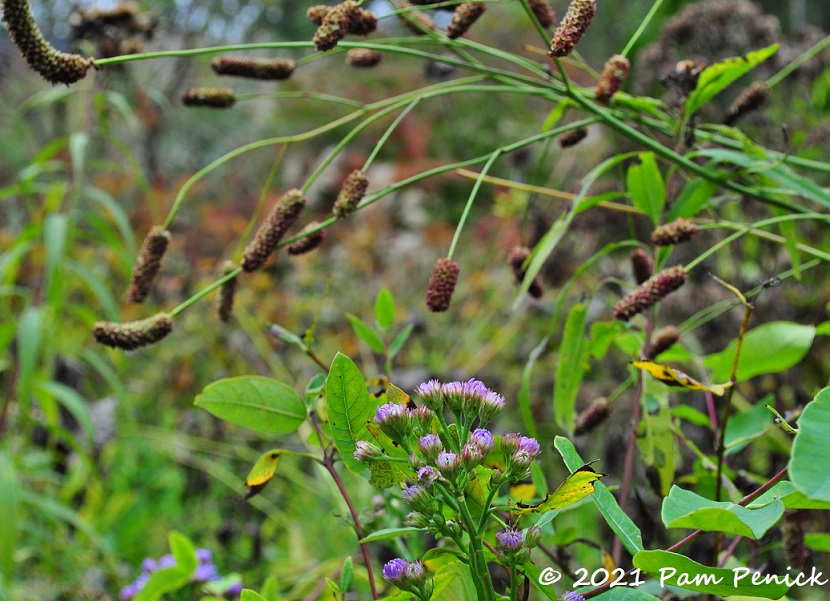
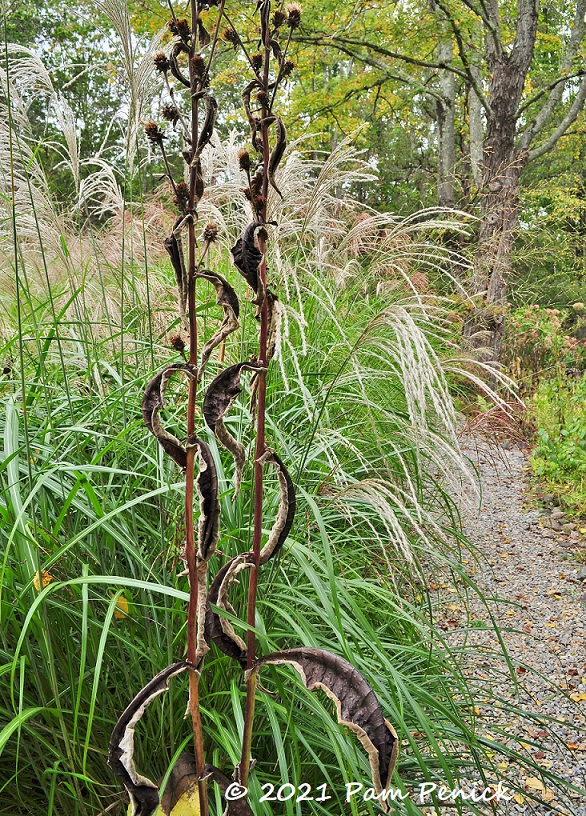
Hydrangea bower
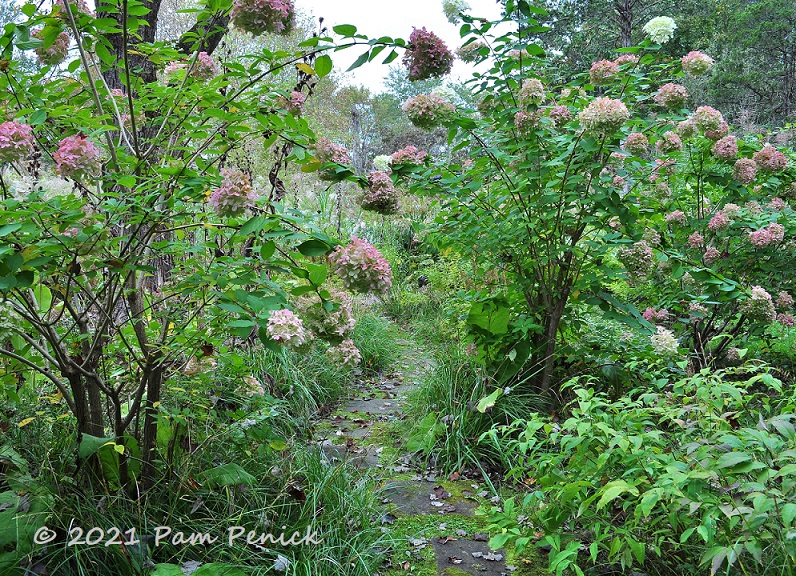
In the farthest corner of the garden, a bower of hydrangeas half conceals…
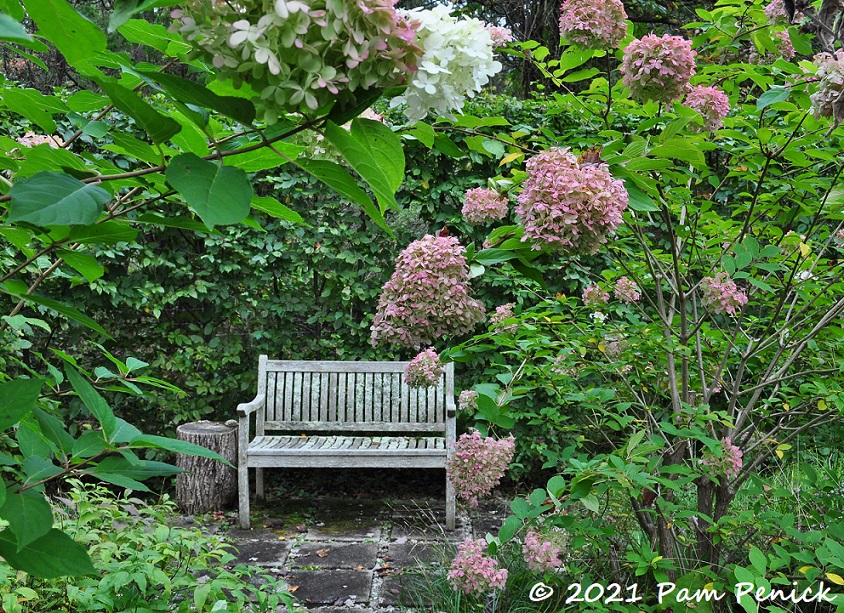
…a garden bench, where we sat for a while and talked of other things than gardens. Gardens are good for that.
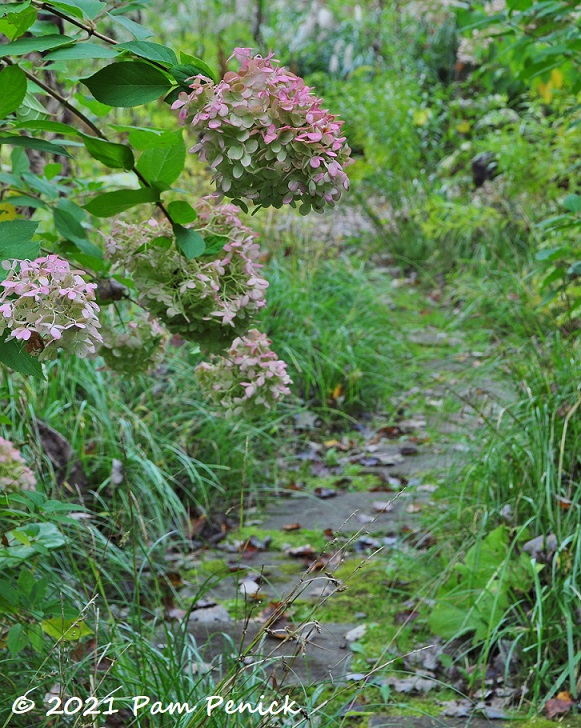
Marc Rosenquist sculpture
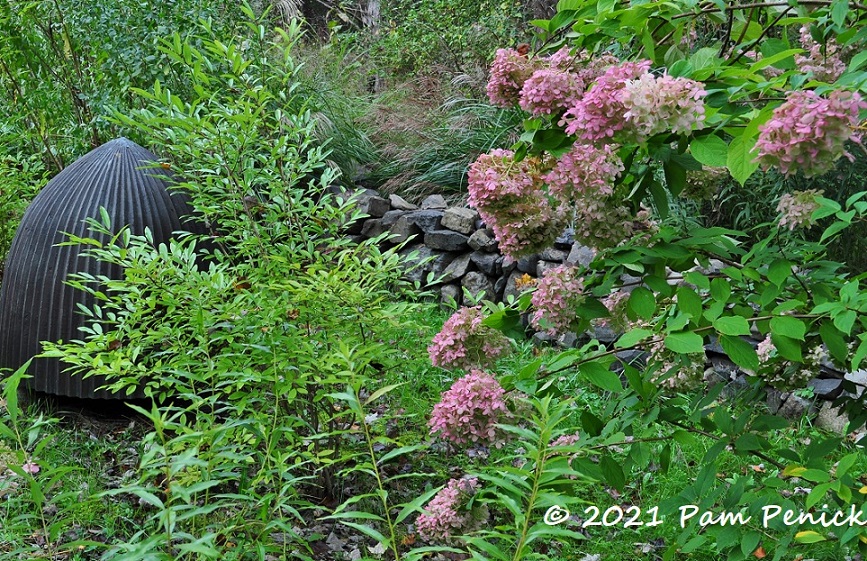
A rounded, ridged conical sculpture by Marc Rosenquist — one of the rare pieces of garden art at Federal Twist — emerges snout-first from the foliage, its dark color echoing the low rock wall behind it.
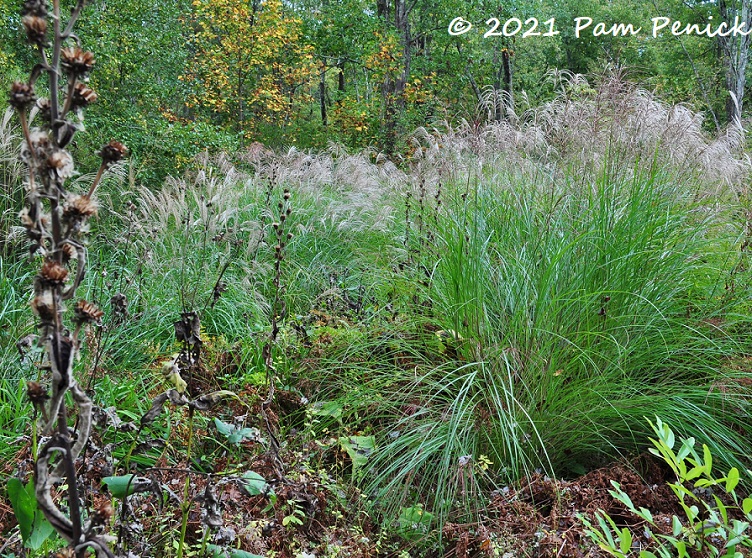
LongHouse tribute
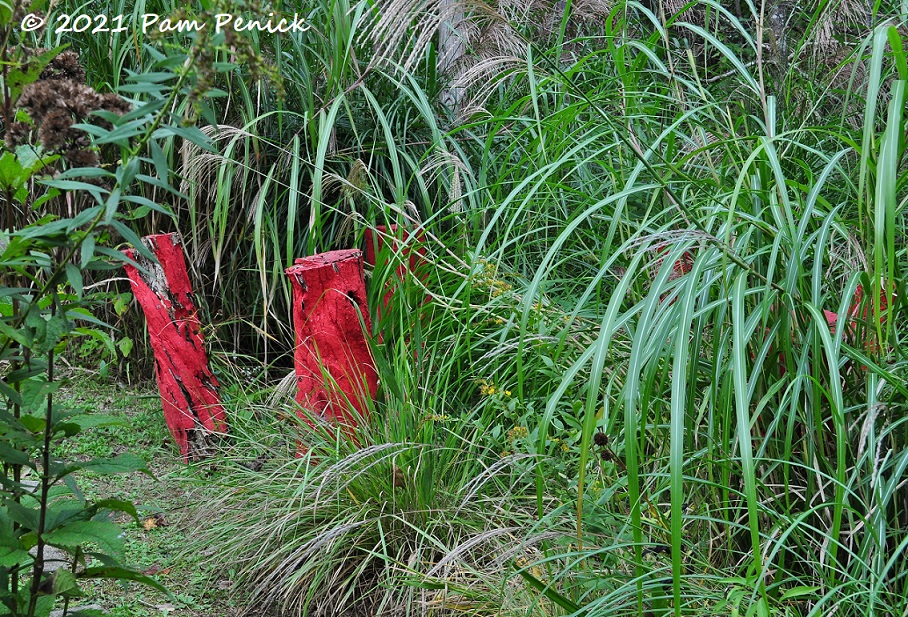
When James heard I’d just visited LongHouse Reserve, he pointed out these red posts along a grassy side path, inspired by the famous Red Garden posts at LongHouse.
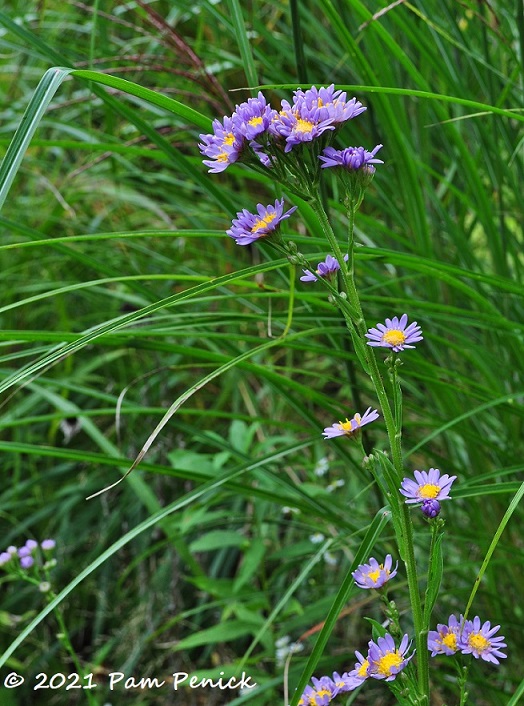
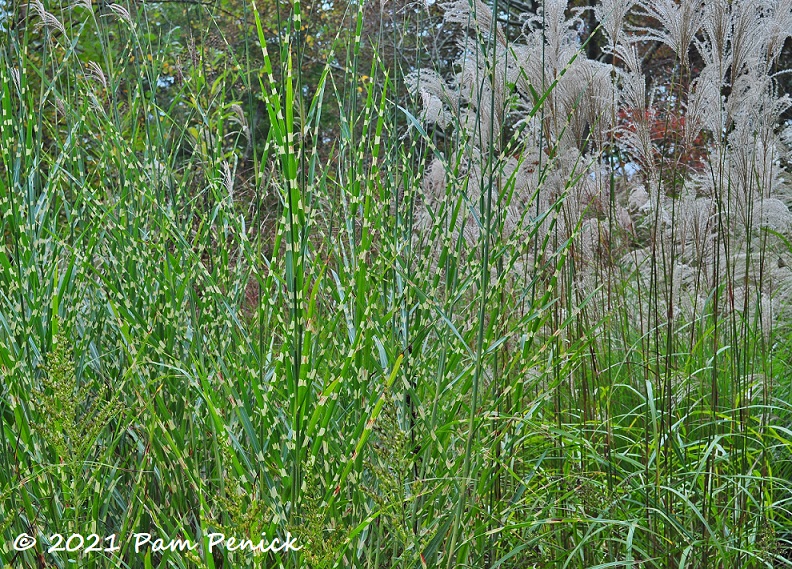
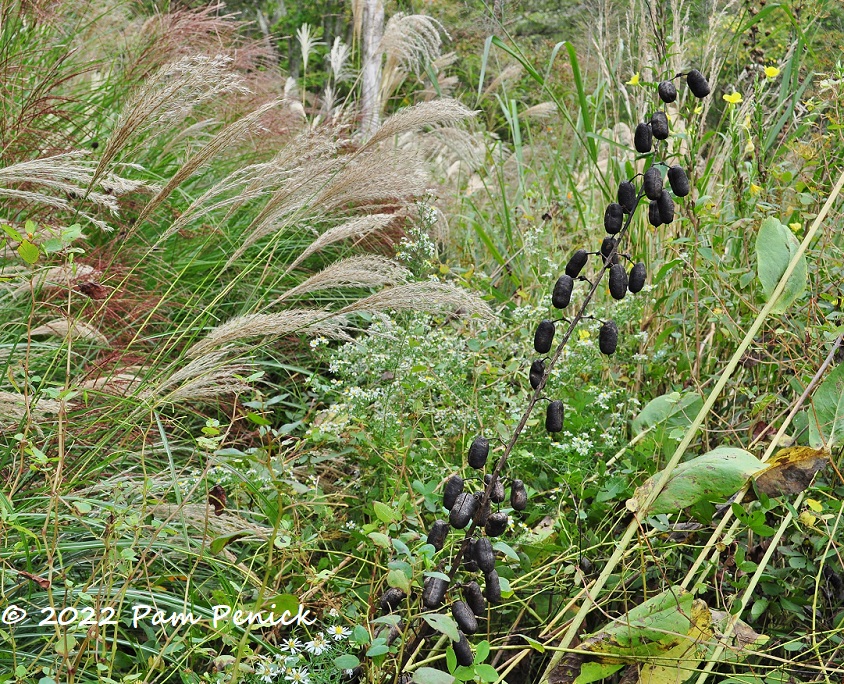
Lower reflecting pool
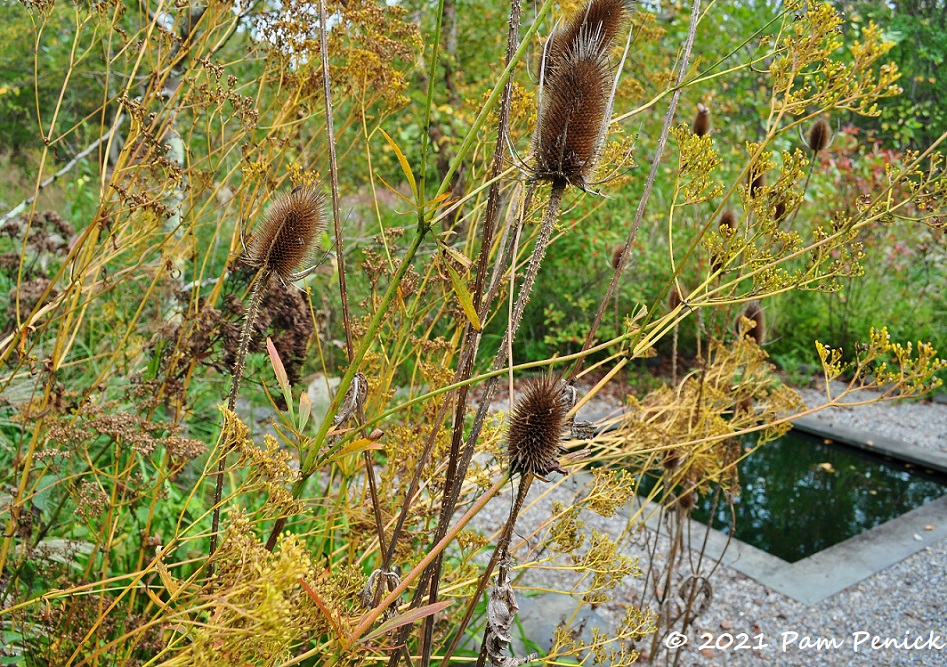
In the middle section of the garden, another open space appears, this one with a square reflecting pool and a couple of chairs to sit and watch the frogs.
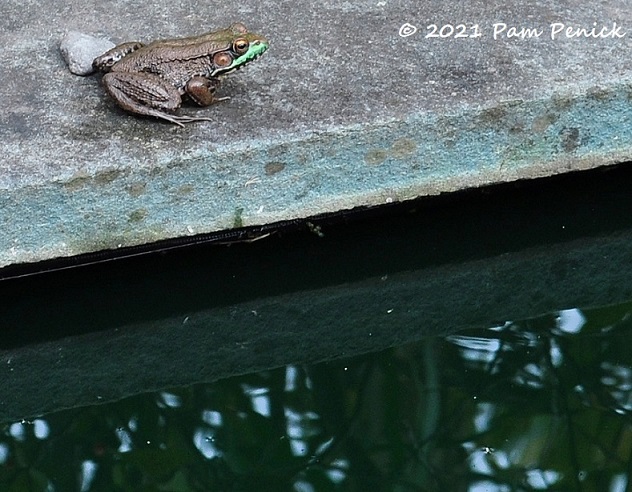
One of which obliged me by posing for a photo.
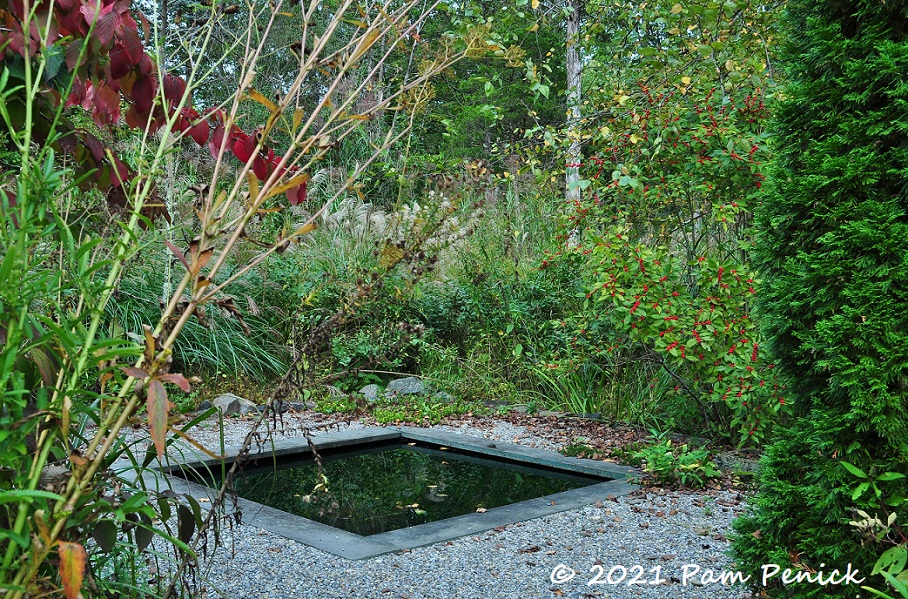
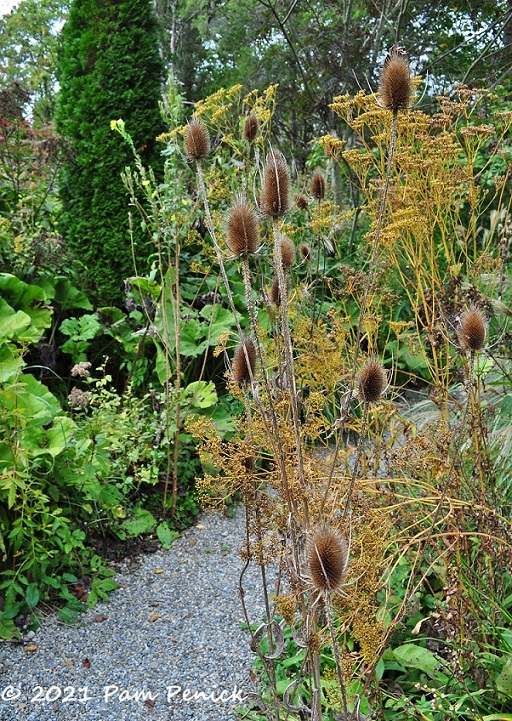
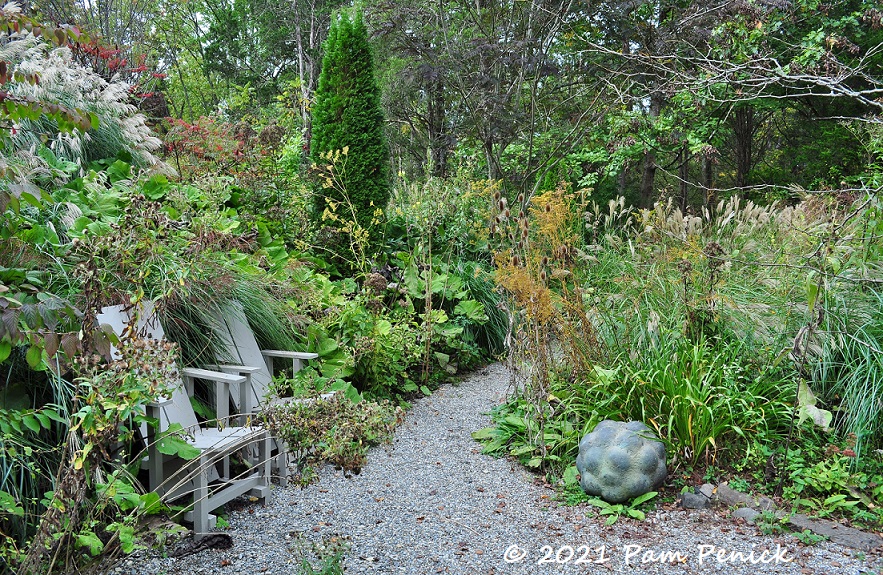
A second sculpture by Marc Rosenquist rests here — a knobby sphere sort of resembling a pollen grain.
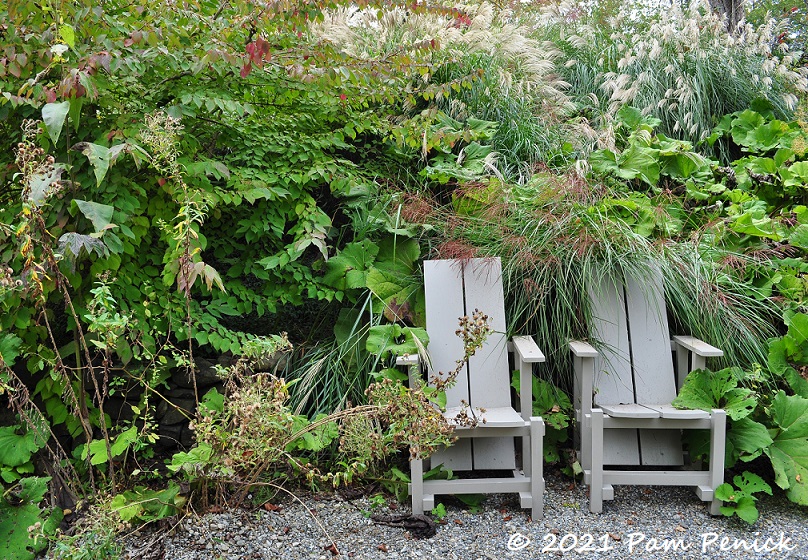
Wave Hill adirondack chairs becoming one with the late-season garden
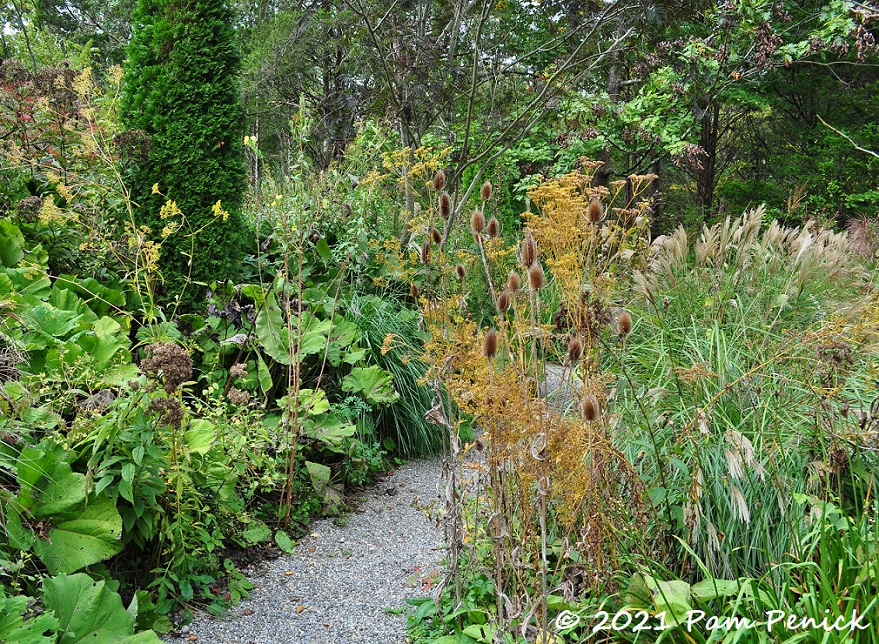
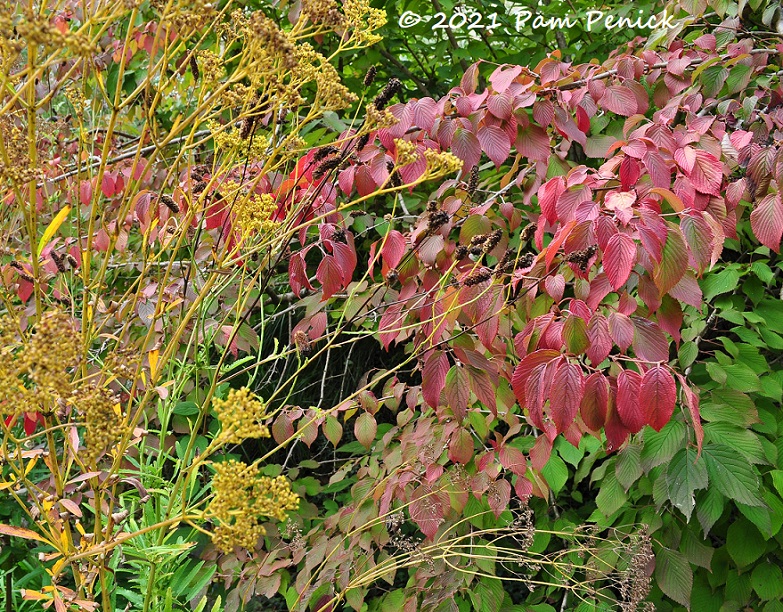
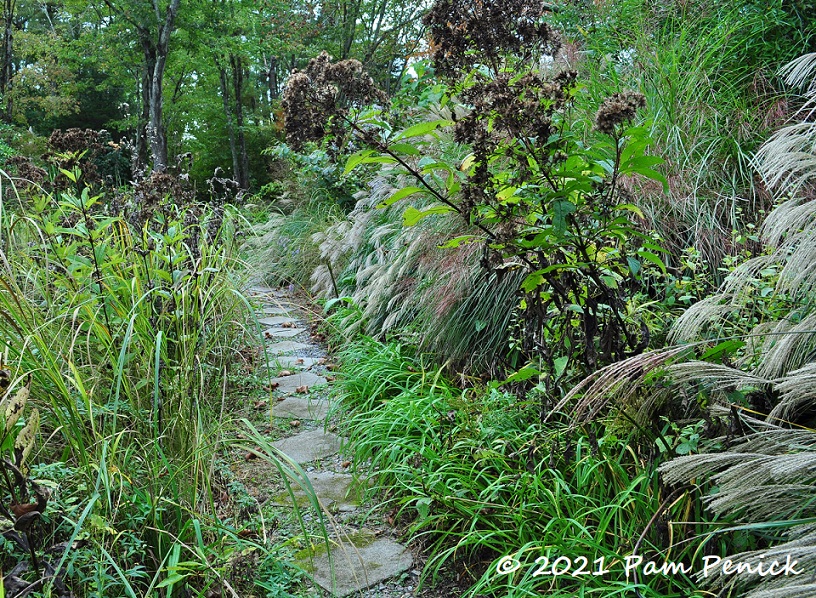
A playful rickrack of concrete steppers leads along another narrow side path.
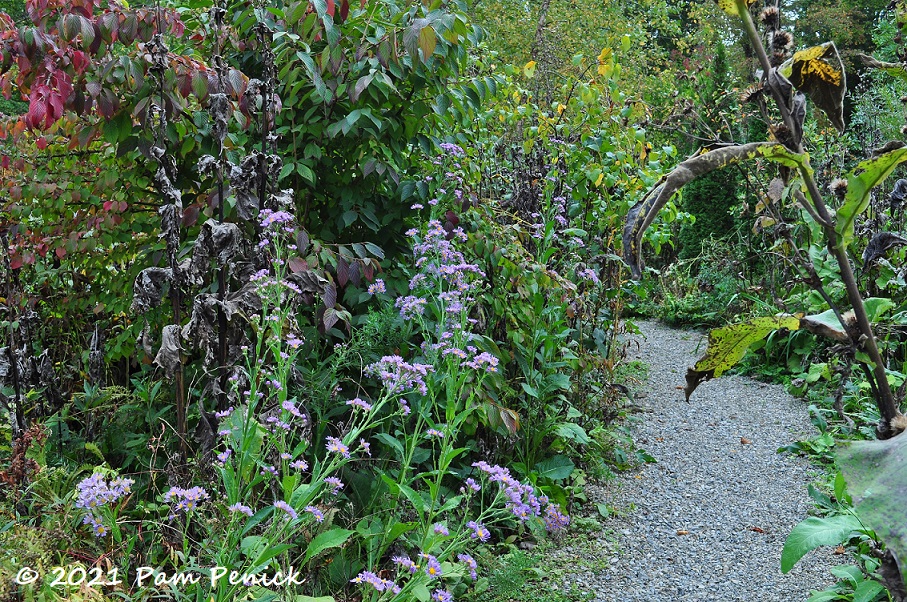
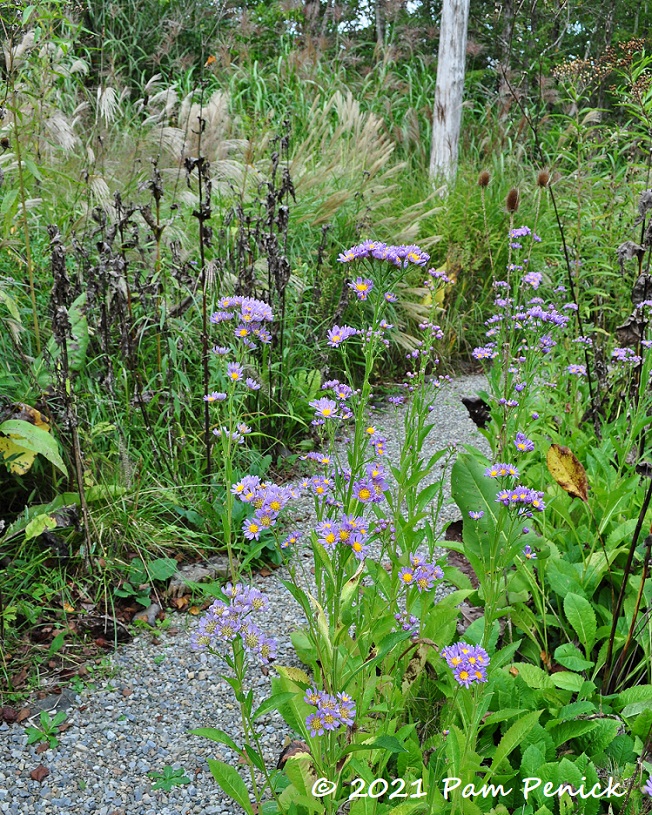
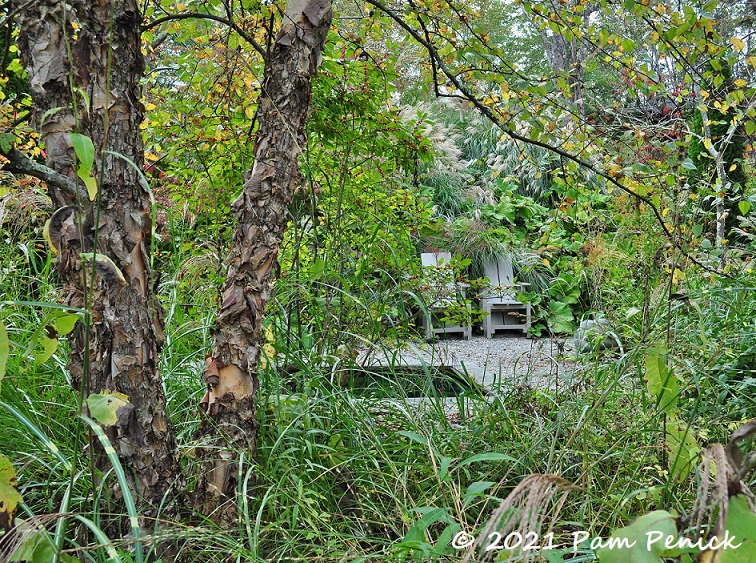
The wandering path eventually reveals a scrim-like view of the reflecting-pond patio.
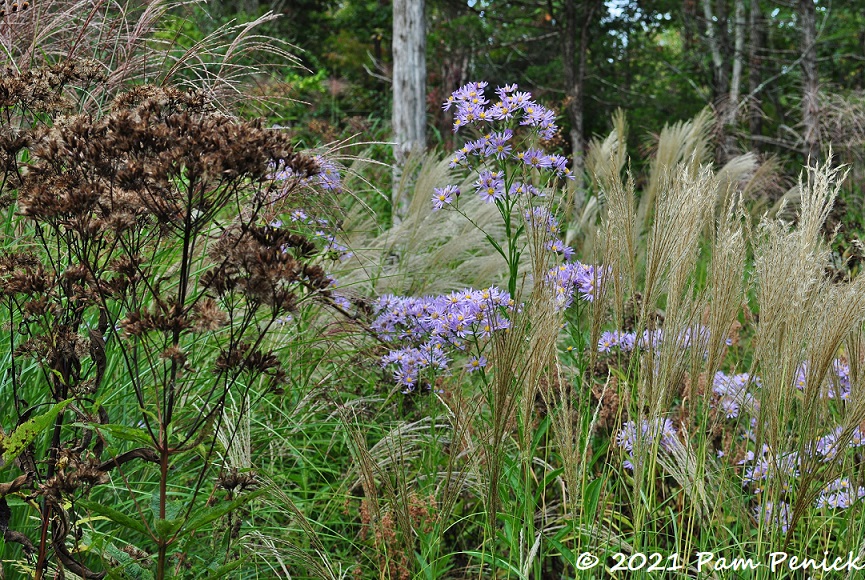
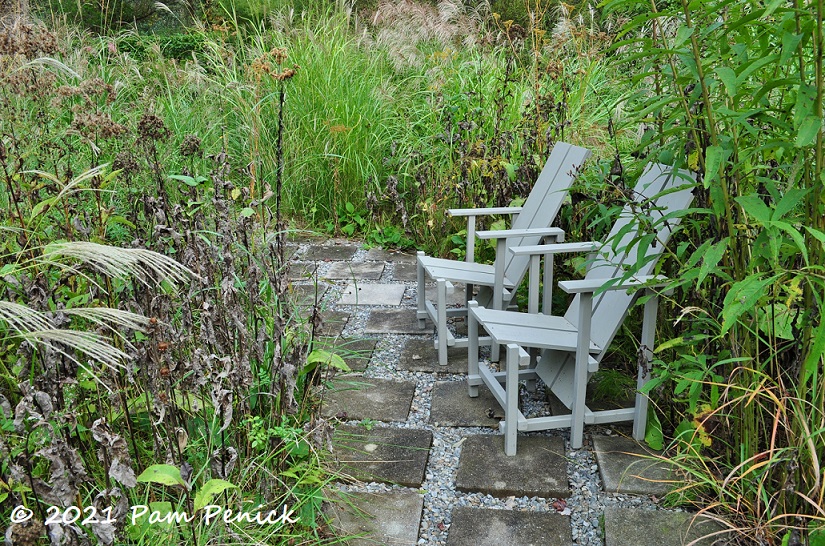
I enjoyed James’s various paving patterns. While the main paths are generally wide enough for two and paved simply with gravel, skinnier side paths and detours entice with square pavers laid in varying patterns.
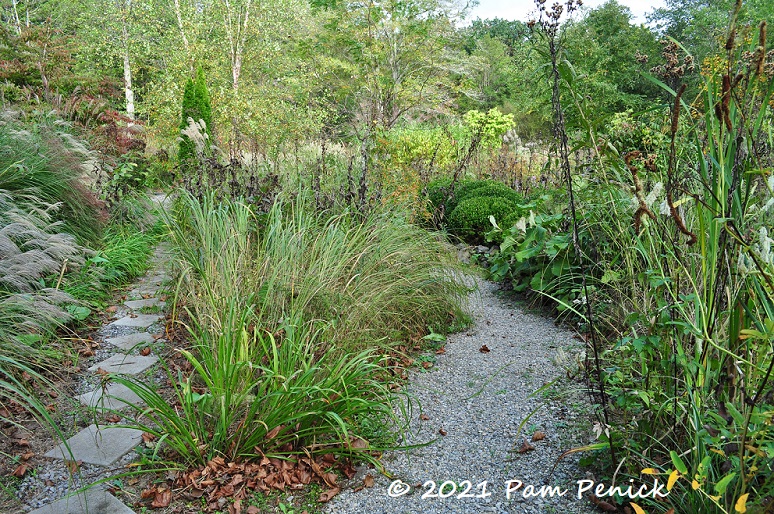
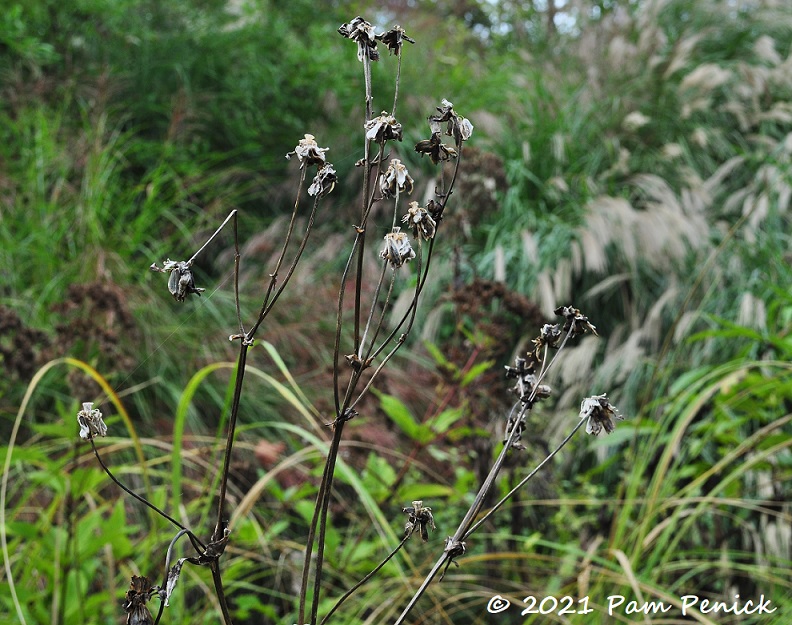
A few formal elements
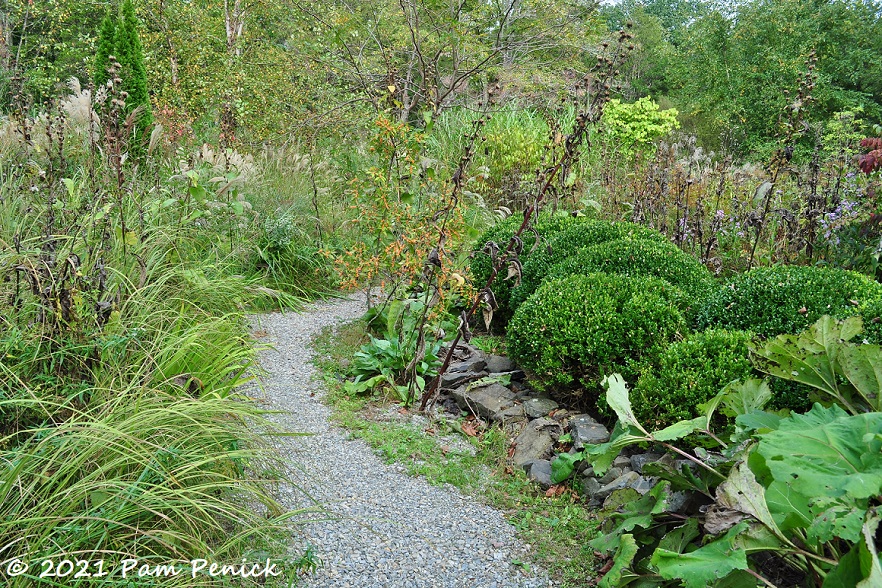
Amid the towering, blowsy foliage, James inserts, here and there, the strong geometry of clipped boxwood and upright arborvitae. Together with the non-living geometric (formal) features — the stone circle and rectangular pools (another is coming up) — they show how the contrast of a strong shape in a naturalistic garden directs the eye, indicates intentionality, and invites you to stop and look.
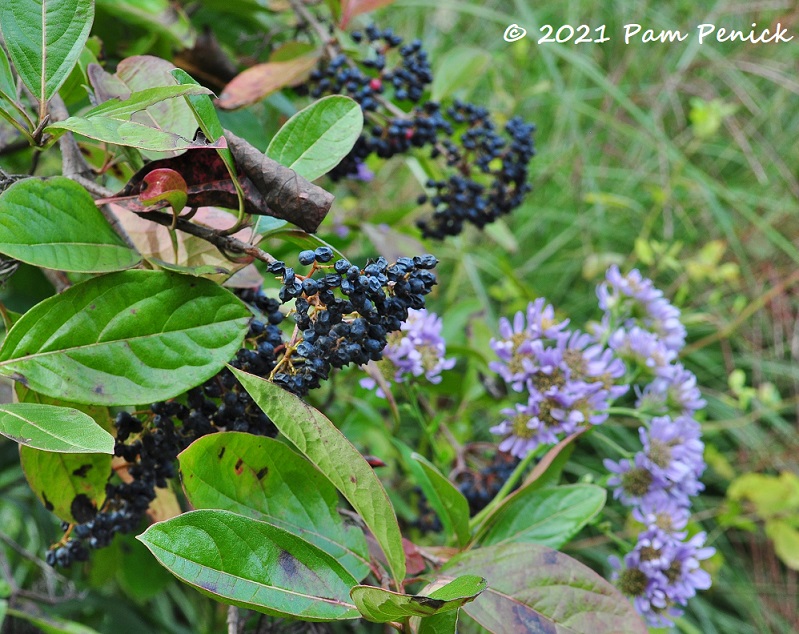
Approaching the house
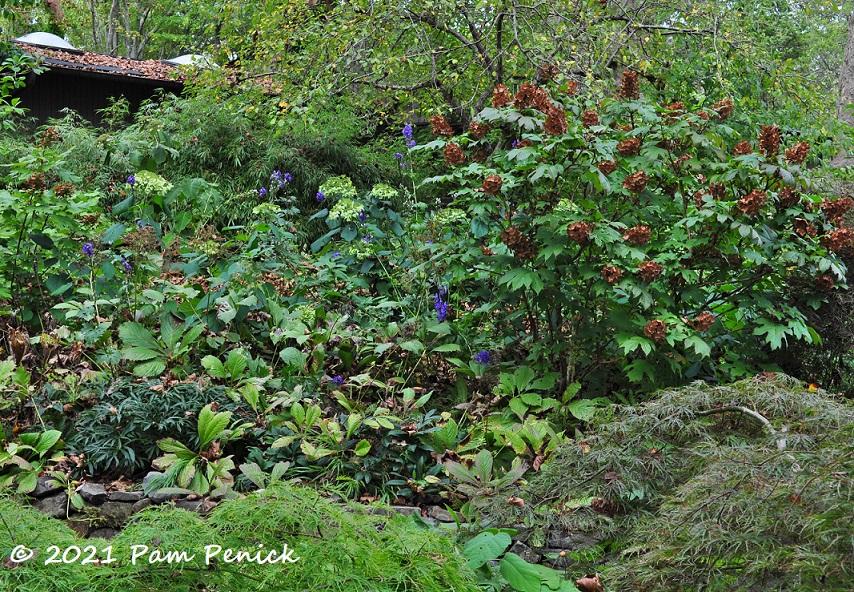
Nearer the house, shade creates an opportunity for different plants.
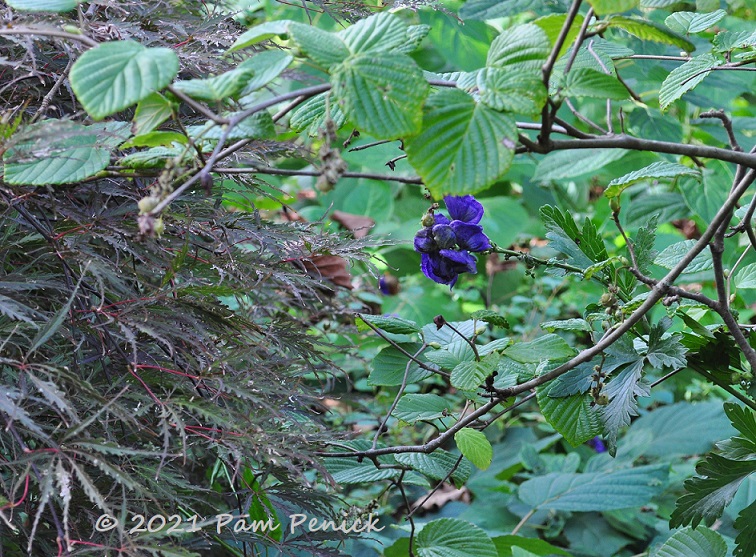
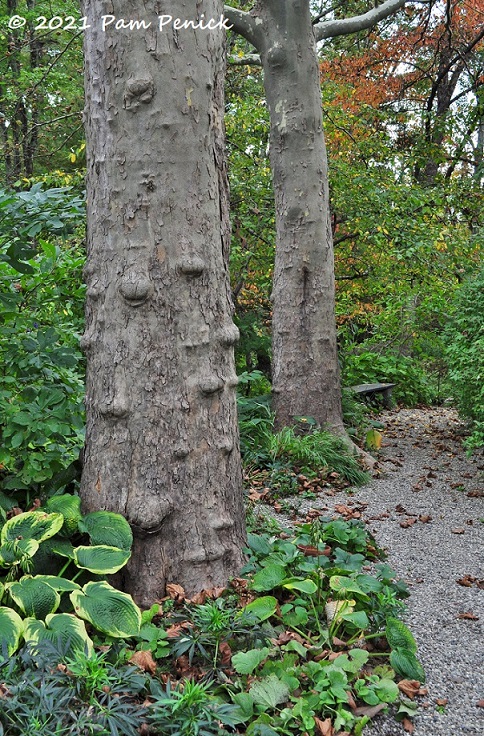
Two grand sycamores make a short colonnade toward a rear terrace.
Terrace
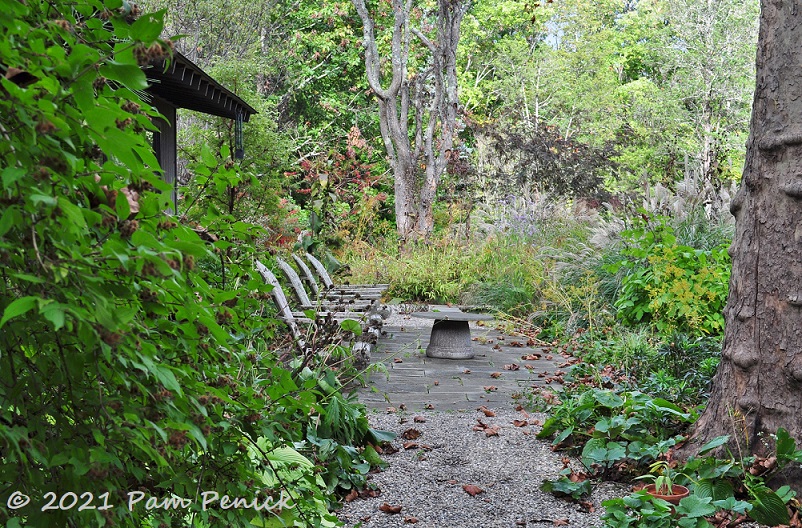
James’s online followers know this view well: a lineup of weathered adirondack chairs and round table on a stone terrace overlooking the wild and grassy garden below — like deck chairs on a steamship overlooking the tossing waves.
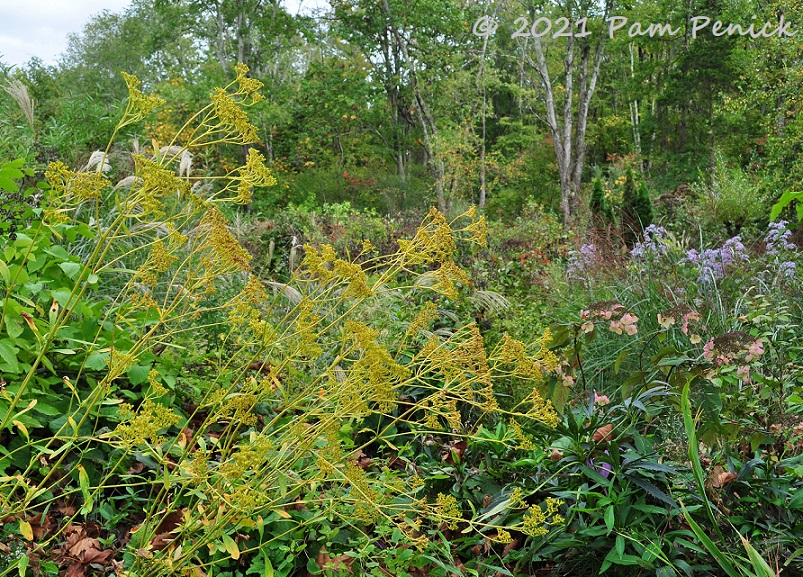
The view
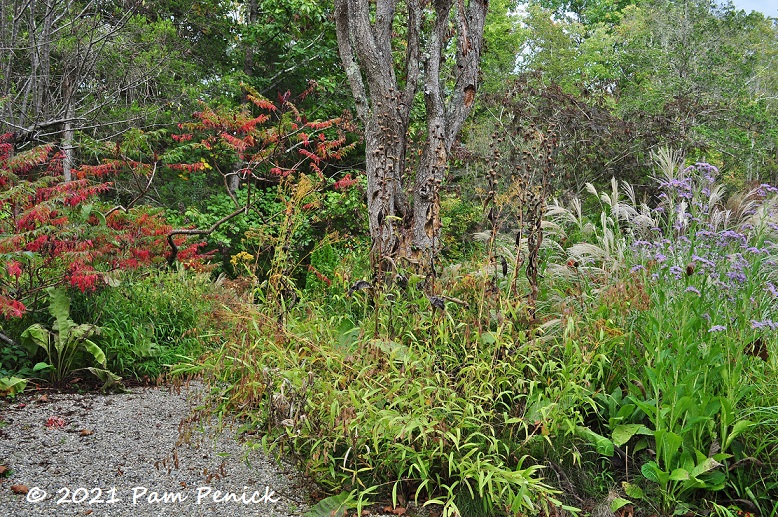
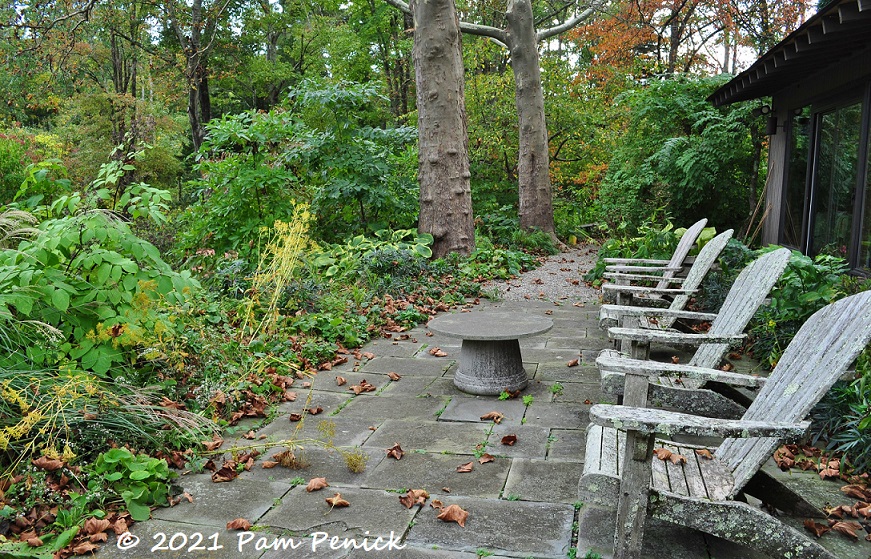
The tall windows behind the chairs bring this marvelous view into the home no matter the weather.
Upper reflecting pool
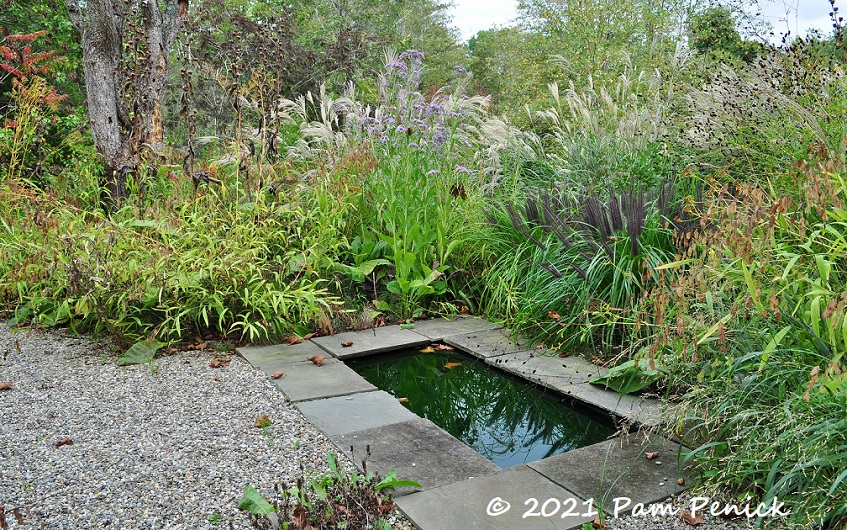
Left of the terrace another rectangular pool, stone edged and dyed black, offers up a reflection of the changeable sky and billowing grasses.
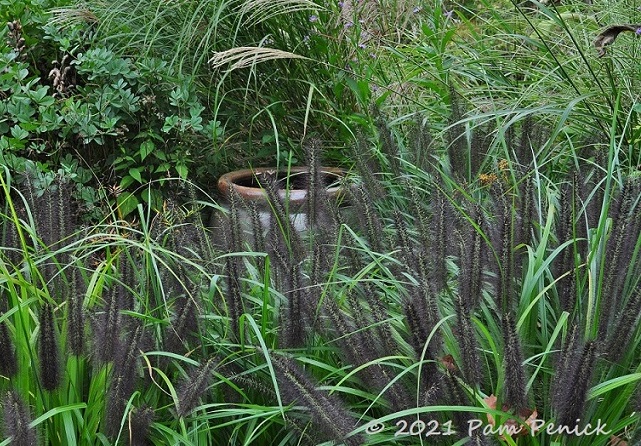
Tucked behind a dark-flowering grass, a pot peeks out.
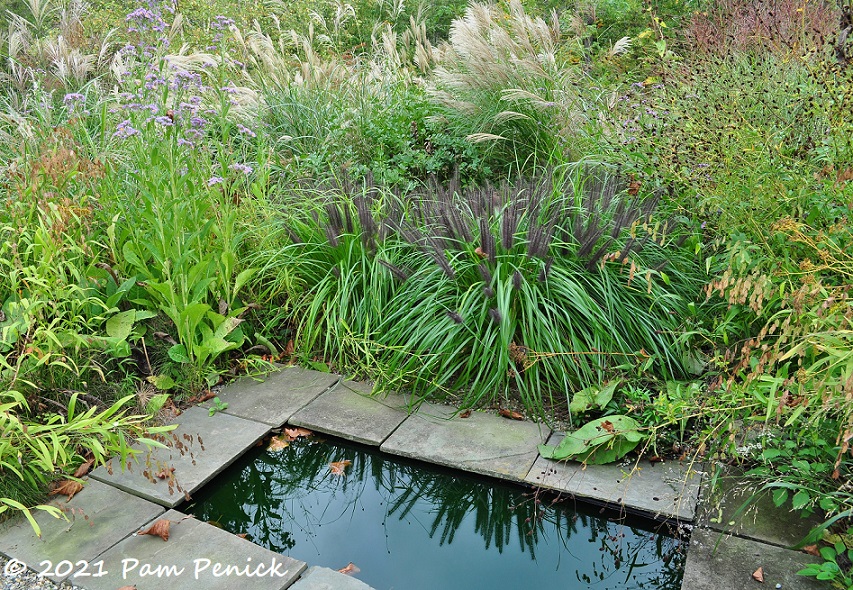

James’s garden has such a sense of movement and energy thanks to all the waving grasses and come-at-me foliage. Thankfully I emerged without having to partake in a Fight Club ritual, and with admiration for the ringmaster gardener who invites his plants to battle it out so beautifully.
Thank you, James, for sharing your garden with me!
Up next: A visit to Winterthur Garden to see its grand trees and pastoral vistas. For a look back at my 3-part series about LongHouse Reserve in the Hamptons, click here.
__________________________
Digging Deeper
Need design help with your yard? Hire me as your personal garden coach! Maybe you need replacement plant ideas after the big freeze. Or maybe your landscaping has grown tired, and you want fresh curb appeal. Or perhaps you’re ready to get rid of some lawn and create a pollinator garden, bird habitat, or hangout space for you and your friends. I’m here to help! Contact me to let me know what’s going on, and let’s figure it out together. My range is Austin and suburbs within a 25-min. drive of NW Austin, but I’m flexible and can travel farther with a surcharge, so let me know where you are. Weekday morning appts. only.
Come learn about gardening and design at Garden Spark! I organize in-person talks by inspiring designers, landscape architects, authors, and gardeners a few times a year in Austin. These are limited-attendance events that sell out quickly, so join the Garden Spark email list to be notified in advance; simply click this link and ask to be added. Season 8 kicks off in fall 2024. Stay tuned for more info!
All material © 2025 by Pam Penick for Digging. Unauthorized reproduction prohibited.


While I couldn’t live with a garden this wild, I know I’d enjoy plowing through it, at least as long as I had a guide so I wouldn’t get lost. Of course, my climate wouldn’t support an accumulation of lush plants like that either. I love the adirondack chair line-up – and the frog.
One of the great joys of traveling, as I know you appreciate too, is seeing gardens very different from our own. James’s was like that for me. It was a treat to see it in person after reading about it for so long.
Even though he’s not blogging at the moment, his posts are so educational and informative, that you can read any of them any time and be inspired. I had to laugh that he doesn’t call his stone circle a “Council Ring.” Up here, in the land of Jens Jensen, there is no question about whether that is a council ring or not. I like his red logs, as we thought about doing something similar as big fans of Larsen.
I agree about his blog posts. They are a treasure. As for the council ring, every time I encounter one I want one in my own garden. Doesn’t matter what we call them, they are powerful spaces in a garden.
Looks amazing. Wonderful good fortune for you to see it in person! Thanks for the tour in photos.
My pleasure to share, HB.
In mid-October, that’s one exuberant garden. I’ll look forward to hearing what he talks about in mid-February.
Thanks for sharing your visit!
Yes, me too, Lisa. I’ll “see” you at his Zoom lecture!
An unphotographical garden which you nevertheless captured beautifully with your camera! I would like to know the identity of the towering grass by the entrance gate.
Thank you, Peter. He did tell me the name of the grasses at the gate — one of the many botanical names that slid by me on the tour. I want to say it was aptly named Miscanthus × giganteus but can’t remember for sure.
This is a terrific garden. I love the layers and the textures. I like the feeling of being held by the garden.
That’s a good way to describe it, Lisa. And friendlier than my tongue-in-cheek fighting analogy! 😉
I like how Golden created a solid design that’s relaxed and natural, with purpose. Like a clearing in the Mid-Atlantic forest that it is, and a specialized “wet meadow”. Thanks for sharing this. Including how you managed to see all you did in under a few hours, the scale of a botanical garden. That would’ve taken me 4 hours without a camera! Bookmarked under “ecoregional gardens”.
Thanks for sharing your always thoughtful take on it, David. As for getting through a garden in a reasonable time (reasonable for the generous homeowner, I hope), here’s my thing: I’m a completionist, and I want to walk every path, see every focal point there is, and stop at every bend in the path and look back the way I came. But I often forget to just stop and sit and absorb. I’m glad I did that in James’s garden, at the hydrangea bench. But dang it, how I wish I’d sat for a few minutes on the terrace up by the house. There’s always something you miss seeing or doing…
What a glorious garden. I love the way water is used.
The geometric water features in his wildly naturalistic garden are genius.
Wow, this garden is a masterpiece! Absolutely stunning!
Glad you enjoyed the tour, Christina. If you’d like to see more, he has a book about his garden coming out in March.